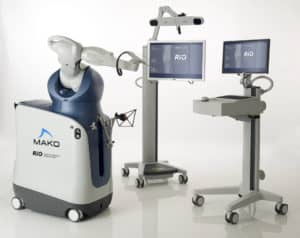A New Way for Partial Knee Replacements
The goal of knee replacement surgery is to decrease pain and restore function in the knee. Although most knee replacement candidates need a total knee replacement, there is a percentage of patients who qualify for a less invasive option. This less invasive option is called an unicompartmental knee replacement, better known as “partial knee replacement.” Partial knee replacement is a procedure that surgeons have used to treat knee pain for approximately 30 years. A partial knee replacement replaces only the worn portion of the joint. It is used in individuals in whom the wear is confined to one part of the knee –
usually the inner or medial side. Therefore, the surgery is localized to the worn joint surface and involves minimal additional surgery on the knee such as ligament surgery. In contrast, total knee replacement replaces all three wearing surfaces of the knee (the lower end of the femur, the top surface of the tibia, and the back surface of the patella) and involves more extensive surgery on the supporting ligaments. Total knee replacement is the appropriate choice for individuals with more severe arthritis, while partial knee replacement is appropriate for individuals with more localized wear on the knee joint.
What are the advantages of partial knee replacement?
Because partial knee replacement is a more limited procedure than a total knee replacement, it can result in a more natural-feeling knee. In a partial knee replacement, the surgeon resurfaces only the diseased portion of the knee, thus preserving the healthy bone and tissue. This can potentially lead to a faster recovery and lower risk of complications such as infection, blood clots, and knee stiffness.
Who is an appropriate candidate for this procedure?
Surgery for arthritis of the knee is typically performed when non-surgical forms of treatment such as medication, injection, and exercise do not provide acceptable relief of the arthritic pain. Patients who are candidates for partial knee replacement usually experience activity-related pain in the inner side of the knee. Startup pain, limping, and pain when standing and walking is common for potential candidates. Because partial knee replacements are performed in patients with less severe arthritis than total knee replacements, patients undergoing these procedures have less preoperative loss of motion than patients undergoing full knee replacement surgery. In addition, their preoperative X-rays show less severe and more localized arthritic changes in the knee.
What is the MAKOplasty partial knee replacement?

MAKOplasty partial knee replacement is a new surgical procedure utilizing robotic technology to accomplish consistent precision surgery in reconstructing damaged joints. The MAKO device uses a preoperative CT scan to assess the bony structure and alignment of the knee. The Robotic Arm Interactive Orthopedic System (shown on the previous page) then allows the surgeon to preoperatively plan the procedure. The surgeon can assess the sizing, positioning, and function of the partial knee preoperatively. During the surgery, the device can confirm that the components are appropriately positioned and functioning. The surgeon-controlled Robotic Arm Interactive System is then used to precisely remove the worn joint surface to prepare the area for placement of the partial knee. It is this combination of CT-guided preoperative planning and surgeon-controlled robotic removal of bone that allows the operation to be done in a very precise manner. This new technology represents a powerful tool to assist the surgeon in performing more accurate and reproducible surgeries. This optimal placement can result in a more natural motion of the knee following surgery.
Are there potential complications from partial knee replacement surgery?

Even though partial knee replacement is considered a minimally invasive procedure, there are still risks associated with the surgery. Although rare, blood clots are the most common complication after surgery. Other complications include infection,
implant loosening, fractures and nerve or blood vessel damage. The main disadvantage of a partial knee replacement is the potential need for more surgery in the future. If osteoarthritis progresses to the other compartments of your knee, a total knee replacement “revision surgery” may be necessary.
In summary, a MAKOplasty type partial knee replacement provides a valuable additional alternative for patients with knee arthritis. It is important to discuss the specific risks associated with MAKOplasty and other treatment options with your orthopaedic surgeon.

Dr. Lane is Board Certified in Orthopaedic Surgery with a clinical interest in Arthroscopic Surgery and Joint Reconstructive Surgery. He attended medical school at the University of Florida, completed his residency at the Harvard Orthopaedic Residency Program and completed his fellowship training in Orthopaedic Surgery at the Cave Traveling Fellowship with the National Orthopaedic Hospital in Arlington, VA; Basil, Switzerland and Paris, France. Dr. Lane is a member of the Amercian Academy of Orthopaedic Surgeons, American Medical Association, Florida Medical Association, and the Alachua County Medical Society.

